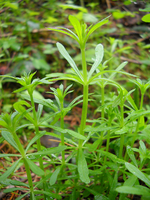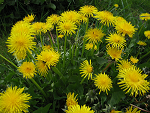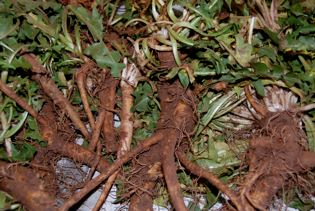 Loading... Please wait...
Loading... Please wait...Blog
A Spring Blessing…Dandelions
Posted by Patricia "Maus" Delgado on 31st Mar 2017
Spring is finally here and summer is close behind, wherever they are allowed to grow freely in meadows, fields and even in my garden, dandelions will flourish. For me when I see these little clusters of leaves forming it lets me know that spring and the beginning of summer is here.
When I think of dandelions, I always remember a story my mom
tells about my Great Oma (Oma Mookie) in
We all have experienced digging these plants out of our lawns, but who knew that the little toothed leaves and golden flowers were reason to give praise as a bounty of food and medicine? All parts of the dandelion are medicinal, the leaves specifically are an excellent diuretic, and roots that are 2 years of age contain the most concentrated amounts of medicinal properties. An added benefit of this little weed is that you can even roast the roots, grind them up and use them as a substitute for coffee!
This little weed is so rich in vitamins and minerals it’s no wonder that it is now recognized all over the world as a must have in your garden as well as in your medicine chest. Being very rich in protein, magnesium, phosphorous, iron, niacin, riboflavin, magnesium, potassium and vitamins A, B 6, C, E and K you would be crazy not to want to pick it and eat it! An amazing find was learning that the leaves contain 7,000 units of vitamin A per ounce, or 1 cup (55g) of chopped dandelion greens provides 112% of the recommended daily Vitamin A intake! With dandelion containing so many vitamins and minerals, it’s no wonder that it treats many disorders and health problems.
If you have digestion-related-ailments or you want to improve the health of your digestive organs, the dandelion is the herb to use. It also improves the health of the liver, gallbladder and kidneys, along with aiding in rectifying blood sugar problems. In other words, it is a basic blood purifier too! With dandelion’s high levels of potassium, iron and vitamin B 6, dandelion is an excellent source to use in the treatment of anemia. It enhances the health of all other organs as well. Herbalists and Herbal Practitioners use the juice of the dandelion root for the treatment of diabetes, liver disease and other liver-related diseases such as eczema and arthritis. Finally, there is glandular activity, which is stimulated and is kicked into action with the juices of the entire plant by improving lymph drainage when mixed with other herbs such as mullein, cleavers and calendula.
Using Dandelion Plants Medicinally:
Tea– For leaf tea use one tablespoon of herb per one cup of boiled water, steep 15 minutes. Drink up to five cups a day. For root tea, combine one teaspoon per cup of cold water in a pan and then bring it to a boil. Simmer about ten minutes, then strain. Drink up to three cups a day.
Infused flower oil – Gather flowering heads on a sunny day. Pull flowers from head base and let them wilt in a basket for half a day. This will help to reduce their water content. Place flowers in a glass jar and cover with extra virgin olive oil. Make sure the oil covers the flowers entirely. If flowers are sticking about the surface they will likely mold. Cover and place in a warm spot like a sunny window, next to a heat source or outside on warm days. Occasionally open the lid and wipe off any condensation that has formed on the underside. This will help remove water from your oil. Let sit about 2 weeks. Strain with muslin cloth (see cottonwood post for photos on how to do this). Let the oil settle for several hours. Water will fall to the bottom. Pour into a clean glass jar, leaving the water part behind. Label and store in a cool dark place for up to a year. Rub on sore muscles or arthritic joints. Use is salves or as a nutritive addition to creams or body oils.
Tincture – In last issue of BE Life I wrote an article on how to make a basic tincture, here is a short version in case you missed it. I only tincture the leaf and roots of the dandelion (separately). Chop up cleaned fresh roots or leaves in small pieces, place in a jar, cover with your menstruum then cover with a tight fitting lid. Label the jar, including the date, and let sit for three weeks, shaking it occasionally. Press with muslin cloth and store the pressed tincture in a glass jar in a cool dark place. Tinctures will last 7-9 years, and do not worry about the milky substance in the tincture that falls to the bottom. This is inulin, and is a natural starchy dietary fiber; just shake the tincture before you use it.
Of course the favorite use of dandelion is still what most if not all of us did as children, picking the flowers when they have gone to seed and blowing their poufy white parachutes off into the wind. Enjoy using this wonderful herb that so many with manicured lawns consider just a pesky weed.
Now on to a few recipes with dandelions, they are greens, so they can be served as most any other leafy green. I do need to caution, the older the dandelion is, the more bitter the greens will taste if eaten raw. It is best that the larger leaves be blanched prior to using to help in removing the bitterness. The age will guide you on how it is best cooked, and of course, the younger the dandelion greens, the better they are raw for a nice wild edible green salad.
Sautéed Dandelions with Olive Oil, Lemon and Garlic
(Young to medium-aged/sized dandelion greens)
Ingredients:
- Washed dandelion greens (as many as you are planning to serve)
- Olive oil
- Minced garlic (or field garlic)
- High quality salt (I prefer Himalayan Pink or Black Lava)
- Fresh lemon
Directions:
- Heat a nice amount of olive oil, and a bit of the garlic, in a skillet.
- Once the garlic has infused into the oil, add your dandelion greens. Sauté them on medium-high until they’re nicely wilted, similar to cooking spinach. About 2-3 minutes. It’s important not to overcook the greens because you’ll lose nutrients the longer they stay on the heat.
- Once they’re finished, sprinkle just a bit of high quality salt on the greens, a little splash with some fresh lemon juice, and your side dish is complete! They’re wonderful to eat plain as a side dish this, or can be chopped and tossed with some pasta.
Sautéing dandelion greens are a great way to cook them because they keep a lot of their nutrients with this method.
Cream Dandelion Greens
(Older and large sized dandelion greens)
Ingredients:
- Washed dandelion greens (as many as you are planning to serve)
- Butter
- Flour
- Minced garlic (or field garlic)
- High quality salt (I prefer Himalayan Pink or Black Lava)
- Onion - chopped
- Cream
- Parmesan cheese
Directions:
- Fill pot with water and bring water to a boil. Drop the leaves in boiling water and leave them in for 2 minutes.
- When you boil the leaves, you’ll need to boil them twice if they are older leaves.
- Then drain the water (see below), fill pot and boil again for 2 minutes.
- While you are boiling the leaves, in a small saucepan over medium heat melt your butter and use your flour to make a nice roux.
- Slowly add the cream to your roux while whisking to combine into a nice creamy white sauce, when the sauce begins to thicken, remove from heat and set aside.
- Remove the dandelion greens from the water and set aside.
- In a skillet, add a small amount of butter, sauté the onions and garlic and then add the dandelion greens to combine the flavors.
- Add the sauce and Parmesan cheese to the skillet, simmer until blended, and add salt and white pepper to taste.
When boiling the leaves, be sure to save the remaining water from the first boil, it’s not only full of nutrients, but it also aids your digestive system, so drink up! The double-boil method will remove a lot of the bitterness in older greens. If you’re boiling young greens, you’ll likely only need to boil them once.
Dandelion Root Coffee
Yes, I do have a bag of dried dandelion root mixed with some chicory root in my kitchen right now, and I can tell you that it does taste like coffee. The biggest difference is that dandelion root is bit more bitter. It’s also caffeine free, and contains more antioxidants and nutrients than regular coffee, so it is safe to say, it is ‘healthy’ coffee!
Roasting dandelion root is really easy. It’s best to dig up the root in the spring and beginning of summer, which is when the roots have the most nutrients.
Ingredients:
- Large pile of dandelion roots
Directions:
- Preheat oven to 250°F/121°C
- Wash and scrub the dandelion roots, just like you would any root vegetable.
- Chop them into small chunks. Then put them in a bowl of water and scrub them one more time.
Place the roots on a cookie sheet and put them in the oven to dry. Leave the oven door open slightly to let moisture escape. You’ll want to stir them frequently to make sure they’re drying evenly and they don’t burn. The drying process will take at least two hours. As the roots dry they’ll shrink and turn to a pretty brown color. Make sure they don’t burn!
Once the roots are roasted, let them cool completely.
Grind them up, then store them in a sealed glass mason jar.
Brewing the dandelion coffee
Ingredients:
- 4 cups of water
- 4 tablespoons of ground roasted dandelion root (you can buy some here if you don't want to make your own)
Directions:
- Place water, ground roasted dandelion root in a pot
- Bring to a boil then simmer for 5 minutes
- Pour coffee through a fine mess strainer.
Add milk or cream if desired
It is important to note, that when making teas with roots, be sure to boil for 2-3 minutes to release the medicinal properties. In my opinion, adding a bit of hot milk takes away the slight bitterness and makes for a truly wonderful cup of dandelion coffee. As mentioned, I have added roasted chicory root to mine for a truly delicious mountain blend that you cannot find in ordinary stores!
Oma Mookie’s Dandelion Cough Syrup
Ingredients (converted from metric):
- 3 cups of water
- 2 cups fresh picked dandelion flower petals, washed. (Be sure they are dry and not saturated with water)
- 2 ½ cups raw honey
- ½ lemon
- 1 tsp wild cherry bark
- 1 tsp licorice root
- Pinch of cinnamon
Directions:
- In a large pan, combine cleaned dandelion petals, water, lemon (peel and all), cherry bark and licorice root over high heat. Bring water to a boil and turn heat off. Cover and let sit overnight, steeping.
In the morning, strain the dandelion lemon bark root infusion, taking care to squeeze out all of the tea from the flowers.
In a pan, combine dandelion infusion, honey, and cinnamon. Simmer over low heat for 1 – 1 ½ hours, stirring occasionally.
Check syrup for desired consistency by dipping spoon into syrup, pulling it out, and letting it cool. It should be a honey/syrup type consistency.
Store in an air tight container such as a Mason jar, in a cool place.
Dosage: Adults can take 1 Tbs. and children 1 tsp. of the syrup up to every 30 min. as needed. Allow the syrup to slowly trickle down the throat as you take it.
This is about it for this blog, I'll squeak at you next month with a new entry.

A Tiny Flower’s Secret.
Chamomile is an herb that originates from a blooming plant in the daisy family. Both new and dried blossoms can be used and can work on a variety of well-being issues. The key oil in chamomile that makes a difference is known as bisabolol, which has many calming and microbial properties. The flower resembles a daisy with white petal and yellow circle florets..Chamomile has [...]

Plantain – An awesome medicinal weed.
I know when my husband Jim first heard me talking about going to pick plantain, he thought I had really lost it! He had been hunting and trapping all over the land where I go to harvest wild herbs and not once had he seen a plantain banana tree! I smiled and lovingly explained to him about Plantago, [...]

Herbs that Lower Cholesterol
Herbs that Lower CholesterolWe live in a pill-popping culture, so it’s no surprise the default method for lowering high cholesterol levels is usually popping some pill the doctor prescribed. So many drugs are readily available and it requires very little effort. Yet studies fail to show that natural herbs, diet and lifestyle changes can be as or even more powerful than [...]

Elderberries are in season!
Elderberries (Sambucus caerulea) are found in our little town of Elbe along the trails in our national forest. Since they make wonderful jams and syrups, my husband and I went foraging and picked about 15 pounds. I ended up selling 8 pounds to a customer who‘s father loves Elderberry pie. The remainder we froze to make pies, cobblers and tarts. [...]

Cleavers, The Herb that Sticks to you
In keeping with my foraging theme, its cleavers season in Elbe, Washington and our farmstead has a bountiful harvest in the back forty. Cleavers (Galium aparine) is a common lawn weed. It tends to grow in shady, moist corners and is most well-known for its ability to cling to clothing and hair. I remember playing with this [...]

Health Benefits of Dandelion and Dandelion Root
Its dandelion harvest time and I have to admit that I have a love-hate relationship with dandelions. Their sunshine yellow heads spread across the field in the meadow behind our farmstead and their tenacity – flowering from February through to November – means they welcome in the colder, grimmer months. The delicate orbs of their seed heads are a harbinger [...]

Stinging Nettles: A weed worth foraging!
Until recent…before I started my research and decided to offer herbal advice and remedies…to me, nettles have always been a little like willow bark — something I’ve gone through life vaguely knowing was medicinal, yet I’d never really bothered to get around to picking and using what my Oma called “Brennnesseln” or what my Opa use to threaten to [...]
Cold & Flu Relief - Herbs That Work
During this time of year, immunity to various colds, flu’s and viruses are a huge topic. You can barely watch a television program or listen to the radio without hearing and seeing commercials about cough drops, syrups, over the counter, non-prescription immunity protection, not to mention the shots that are so conveniently provided by various [...]

Organically grown vs. Certified Organic
Organically grown vs. Certified OrganicOne of the biggest questions asked here at Mountain Maus' Remedies is what is the difference between organically grown herbs and certified organic herbs? When we began our farm we wanted to be able to use the word “organic” to describe our naturally grown herbs, because, well , that is what they are, right? [...]





